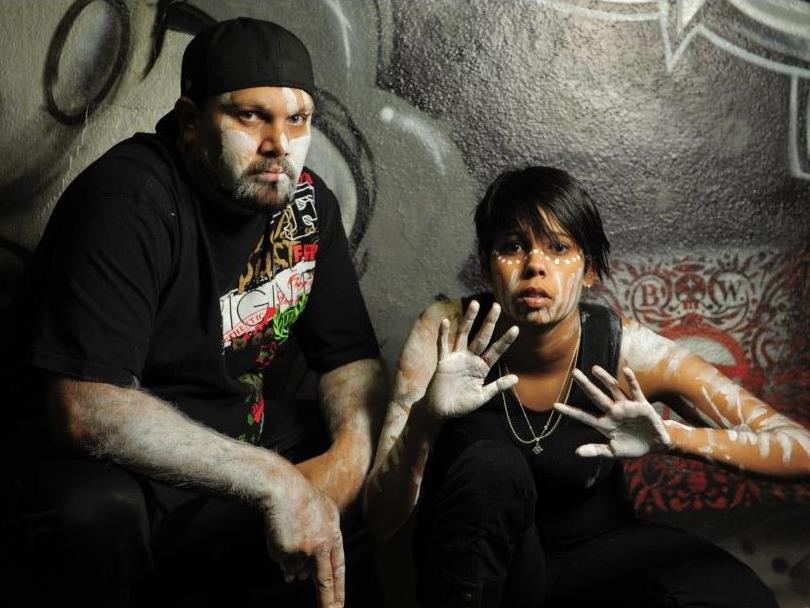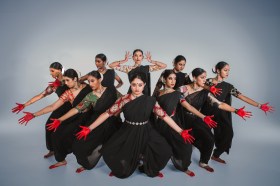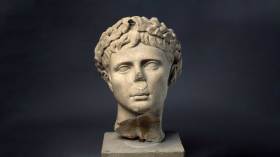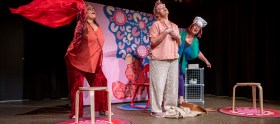Karnage and Darknis. Image supplied.
For those living in major cities, it’s hard to conceive the importance of the Central Australian Aboriginal Media Association (CAAMA).
CAAMA’s broadcast convoy rolls from Darwin to Ceduna right through Central Australia, second only to the ABC, with 600,000 listeners tuning in at any given time.
But CAAMA is much more than just a radio station. The four arms of its training program – radio, music, productions and technical – provide pathways to self-expression, autonomy and cultural revival for Indigenous people across regional and remote Australia.
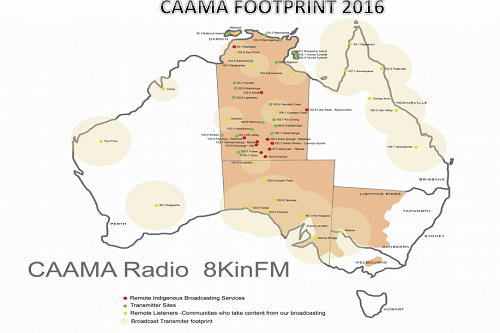
Image: supplied.
Changing lives
CAAMA is a crucial training organisation in communities that have few career opportunities.
Many of its alumni have gone on to tell stories through television and film at the highest level. Actor Trisha Morton-Thomas (Aunty Mona in Redfern Now) got her start at CAAMA. So did AFI award-winning directors Rachael Perkins and Daniele McLean. Beck Cole took her CAAMA training to make the official Sundance selection and cinematographer Warwick Thornton went from CAAMA to the CAANES and Berlin Film Festival and won both!
Recent trainees are keeping this record on track. Viviana Petyarre won a NITV Spirit Initiative award this year and at the Inaugural Capricornia Film Awards CAAMA trainees won Best Short Documentary, Best Short Film Award and Best Documentary.
These high profile success stories are only the tip of the iceberg. By providing a voice and training to young Indigenous people CAAMA empowers entire communities, changing lives both practically and psychologically.
CAAMA is an important contributor to the massive and important task of ‘closing the gap’ in economy, health and education that separates Aboriginal communities from the rest of Australia.
Because of this, CAAMA is contributing to the broader Australia and not just isolated communities.
Recent research suggests that raising Indigenous life expectancy, employment and income levels to those of the wider community i.e. ‘closing the gap’, would increase the country’s GDP by 1%, the equivalent of $10 billion. Since this increase in GDP is larger than the forecasted increase of the country’s total population, this would raise the national living standards for all Australians.
Indigenous economic development is not just a concern for Indigenous communities – it is an Australia-wide economic issue.

Vivianna Petyarre with NITV Spirit Award. Image supplied.
Preserving heritage
While generating livelihoods, CAAMA also works to preserve and archive the ancient and rapidly disappearing songs and history of the Indigenous cultures they serve.
Sometimes the recordings are the only remaining proof of whole languages and histories, and CAAMA is racing against the clock to preserve more of them before they too slip away.
The staff at CAAMA regard this work as present-day history making, and are proud of how the mobile age has changed the scope of their mission. They proactively adapt to multimedia and digitised forms to spread Australia’s original owners’ unique and significant stories.
Preserving this cultural material is essential. It is the oldest and most vital heritage in Australia.
But there are recordings at CAAMA no one has heard since they were produced. And others can only be heard by a select few, (being secret business, some, the last of its kind), deteriorating on tape, in a vault, in Alice Springs.
To preserve the work, the ‘not-for-profit’ station needs funds, but CAAMA also has to keep the show on the road, always ready to capture more recordings of disappearing history in a symbiotic marriage between tradition and modern technology.
Explore the range of CAAMA programs
The cost of cultural vitality
Trucks ferry trainees from project to project through mud, heat and cyclones, taking a toll on resources even if it raises spirits.
Life at CAAMA is a constant balancing act. Trainees are paid while they complete their courses, and there is space for ten more young people right now, but everything depends on funding.
It costs around $50,000 to train a young person in production skills, and while it’s money well-spent, it’s very hard-earned. The dedicated CAAMA staff strike a constant balance between the demands of the future and the duty of the past: take on more trainees, or channel more resources to the preservation of history? In a better world, such a choice wouldn’t be necessary.
CAAMA is a registered Deductible Gift Recipient with the Australian Taxation Office. You can support the work of CAAMA by making a fully tax deductible donation (you will be issued with a receipt for tax purposes). All donations are gratefully received.
****LATEST UPDATE****
CAAMA Music’s artist Gawurra has been nominated in the 2016 ARIA ‘Best World Music Album’ category.

